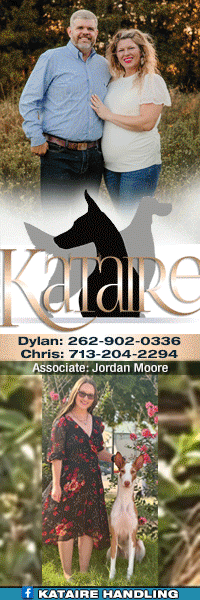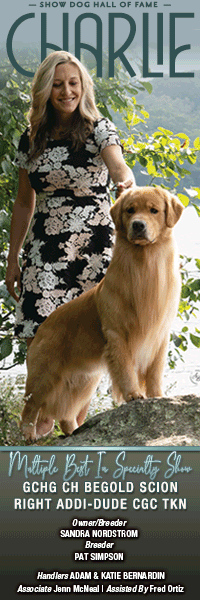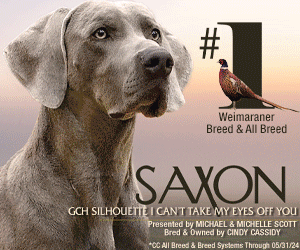Hunting for Greatness
Click here to read the complete article
Maridor Kennels
By Amy Fernandez
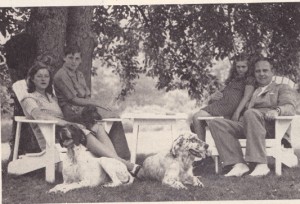 People begin showing dogs for many different reasons. In general, anything short of true dedication is bound to fail. But never say never. Dwight Ellis jumped into the game in 1934. Described as pleasant, gray-haired, and shortish, he owned several textile mills in Springfield, Massachussetts, and it’s fair to say that his situation was comfortable. Like other wealthy Northeastern gundog lovers of the era, he owned a private game preserve. His personal paradise encompassed several thousand acres outside Atlanta. Christened Maridor Plantation, it was named after a locally famous Massachusetts nightspot, a choice that signified his approach to dog sports.
People begin showing dogs for many different reasons. In general, anything short of true dedication is bound to fail. But never say never. Dwight Ellis jumped into the game in 1934. Described as pleasant, gray-haired, and shortish, he owned several textile mills in Springfield, Massachussetts, and it’s fair to say that his situation was comfortable. Like other wealthy Northeastern gundog lovers of the era, he owned a private game preserve. His personal paradise encompassed several thousand acres outside Atlanta. Christened Maridor Plantation, it was named after a locally famous Massachusetts nightspot, a choice that signified his approach to dog sports.
It got a shakeup in 1932, which quite possibly encouraged him to try conformation dog shows. After retirement, Atlanta’s golfing legend, Bobby Jones, decided to build a golf course for his hometown. He purchased an abandoned indigo plantation in 1930. After two years of construction, Atlanta’s first 18-hole public facility opened in 1933 right next door to Maridor Plantation.
After 35 years, Ellis was pretty well set in his lifestyle of upland bird hunting with good gundogs. He had owned countless good setters and developed his eye for type and quality the old fashioned way, by using them in the field. His hunting kennel had been built from the best bloodlines, and it started getting noticed in a whole new way around that time. English Setters were a hot breed throughout the 1930s. AKC registration numbers shot up and they consistently ranked among the top ten breeds shown in conformation. Those stats reflected the breed’s tremendous depth of quality and as the competition ramped up, the bar was raised even higher.
Ellis had consistently dismissed the idea of showing his hunting dogs until Bobby Jones’s project began disrupting his customary vacation routine. That’s when he finally buckled to peer pressure and decided to try his English Setters in the conformation ring. Maridor broke out at a truly inopportune moment. He faced incredible breed competition from celebrated kennels like Happy Valley, Mallhawk, Blue Bar, Rockwood, and Marional to name a few. Champions vying for wins beyond that level faced off against breeds that seemed to produce endless quality during that era. Ch. Nornay Saddler and Ch. Crackley Striking of Wildoaks were just a couple of the many indomitable Fox Terriers campaigned during those years. Likewise, Blakeen Poodles and Giralda Shepherds were just two of the big kennels campaigning an endless string of big winners in those popular breeds.
Naturally competitive, Ellis didn’t do things halfway. When he decided to get in the game, he went all the way. He registered his prefix with AKC in May 1935 and built a kennel in East Longmeadow, near his Springfield mills. Maridor Kennels spread over 50 acres surrounded by cyclone fencing, with 400 additional acres leased for training. This dazzling operation was profiled by AKC Gazette editor Arthur Fredrick Jones in January 1937. He regularly featured America’s finest kennels for this series, but this one blew his mind. He wasn’t the only journalist to call it a canine luxury hotel.
Ellis’s years of managing textile plants honed his ability to streamline production. Mechanical engineering blossomed in every aspect of kennel design. Maridor innovations included customized trimming tables combined with shallow tubs for bathing and trimming. His trimming room also featured some of the earliest cage dryers built into grooming stalls. The kitchen, infirmary, and obligatory isolation kennel were equally state of the art. Concrete runs were outfitted with mechanized doors and custom-made quilted canvas cots. The lounge and trophy rooms emphasized luxury with elegant touches like plaques commemorating every Maridor champion. Ellis designed his own lightweight crates with sliding doors and ventilated panels which fit perfectly into Maridor trucks custom-built at a time when show vehicles were an entirely new concept in dog transport. Jones explained that Maridor setters traveled to bench shows in a light Dodge truck with a commercial body. For field trials, they used a Ford with a customized depot wagon body.?Jones wrote, “It is necessary to maintain two cars because often the same day finds Maridor competing in both branches of the sport. Besides these arrangements, Mr. Ellis, who often likes to take one or two dogs to a trial or for a day’s shooting, has built into his Lincoln Zephyr a carrying compartment.”
Before 1934, Ellis had bred setters strictly for utility. Typically, that doesn’t make for a seamless transition into the conformation ring, but Maridor was getting noticed. Ch. Punch of Maridor finished easily. His best dogs, the littermates Lakeland’s Yuba and Dawn, sired by Rummy Stagboro, were picking up wins at major shows like Westminster and the ESAA National. Then, Ellis’s concept of dog show success underwent a complete transformation when he laid eyes on Sturdy Max at Westminster in 1934. Charlie Palmer handled him to Best of Winners in his ring debut. He also took Winners Bitch with Lakeland Peaches then made it a clean sweep by going Best of Breed with Ch. Richardson’s Byng over an entry of 88, including BIS contenders like Gilroy’s Chief Topic and Country Gentleman.
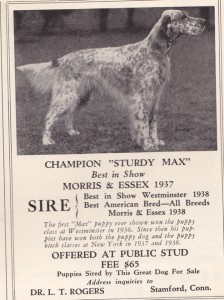 It was impressive, but Ellis was riveted on Sturdy Max, a rather unassuming name for such a glorious dog. But Max wasn’t in the ring simply for wins. He had a much bigger agenda. Back then, commercial dog food was breaking out of its specialized niche and competition for this new, mainstream market was cutthroat. Advertising had been there all along, but canine celebrity endorsements were relatively new. If dogs sold product, why not put the company name right out there. (AKC eventually discouraged this practice, but it worked like a charm back then.) Major players like Carnation bred and campaigned their own Scottish Terrier champions but English Setters became the cereal box icons for this emerging industry. At the time, Baloration had Ch. Gilroy’s Chief Topic and Proto Dog Food had Ch. Blue Dan of Happy Valley. Deitrich and Gambrill were campaigning Ch. Rock of Stagboro under the D&G Dog Food Company banner.
It was impressive, but Ellis was riveted on Sturdy Max, a rather unassuming name for such a glorious dog. But Max wasn’t in the ring simply for wins. He had a much bigger agenda. Back then, commercial dog food was breaking out of its specialized niche and competition for this new, mainstream market was cutthroat. Advertising had been there all along, but canine celebrity endorsements were relatively new. If dogs sold product, why not put the company name right out there. (AKC eventually discouraged this practice, but it worked like a charm back then.) Major players like Carnation bred and campaigned their own Scottish Terrier champions but English Setters became the cereal box icons for this emerging industry. At the time, Baloration had Ch. Gilroy’s Chief Topic and Proto Dog Food had Ch. Blue Dan of Happy Valley. Deitrich and Gambrill were campaigning Ch. Rock of Stagboro under the D&G Dog Food Company banner.
William Marshall Crull founded his Syracuse-based Sturdy Dog Food Company in 1930. When he decided to expand beyond the local hunting and field trial market a few years later, a BIS English Setter was the obvious strategy to conquer that lucrative consumer base of breeders and exhibitors. He chose well. Whelped in 1932, littermates Sturdy Max and Belle were sired by Rummy Stagboro out of Rummey Girl of Stagboro. Owned and promoted by Sturdy Dog Food and handled by Charlie Palmer, Sturdy Belle went Winners Bitch at the 1934 National Specialty, but her record was far overshadowed by her brother. Max, a 65 pound orange belton finished undefeated and was sailing into Best In Show wins by the spring of 1935.
Ellis watched for over a year, becoming increasingly convinced that this dog was the final ingredient to take Maridor over the top. Quite possibly Palmer suggested Max as a nice match for his linebred Lakeland Kennel bitches. Palmer, a veteran English Setter handler from upstate New York was very familiar with the bloodline and its potential. In June 1936 Ellis purchased Max from Sturdy Dog Food for $2500, an astronomical sum back then. It was a big gamble, but within a few months it was obvious that he hit the jackpot. Palmer continued handling him and also began managing Maridor’s 33 Setters and Pointers. Ellis had great stock and money galore, but Palmer was the linchpin that made it work.
The 1937 Morris & Essex show, with over 4000 entries, then qualified as the world’s largest dog show. That’s where gundog expert Dr. Samuel Milbank awarded Sturdy Max Best In Show, making him the first English Setter to win at that level. Sturdy Max never walked out of the group ring without a placement, accumulating a show record of 12 BIS and 22 Groups. He took BOB at the 1937 National, with BOS going to Desire of Maridor. She was another Rummy Stagboro daughter out of Lakeland’s Nymph, dam of Ch. Lakeland’s Dawn. Dawn had finished at Westminster in 1936. She was among the first Maridor bitches bred to Max, her tightly linebred half brother. The result can be called the litter that shook the world. Whelped March 18, 1937, Ellis kept four orange beltons from the litter of nine, imaginatively naming them Dora, Mora, Daro and Maro.
The breakout star was Maro. In 1938 Dawn’s brother, Yuba, took BOB at the National and her pup, Maro, started his career winning the futurity. Within months he won the Sporting Group at M&E and began collecting his phenomenal BIS record. Considering that Ellis had been in the game for less than three years, this success was astounding. However, it paled in comparison to his crowning achievement.
Daro was considered the pick of the litter and in 1948 he did something that ranks among the most amazing feats of American sports. At 11 months of age, still unregistered, he walked into the ring at his first show and made history. Handled by Palmer, he not only defeated a ring legendary dogs to take the breed from the puppy class, he won the Sporting Group over seasoned competitors like the Irish Setter Ch. Milson O’Boy and the Labrador Ch. Banchory Trump of Wingan.
John Bates judged Best In Show that year. He had made his own Westminster history by winning back to back Bests in 1930 and 1931 with his Wire import Ch. Pendley Calling at Blarney. When interviewed about his unexpected decision, his forthright comments about Daro were widely quoted. “That setter just teems with quality. He has a beautifully-chiseled head, a fine depth of muzzle, and is a clean one all over. It isn’t necessary to say anything about his perfect shoulder placement and conformation. No dog could move that way if he wasn’t built right. He gives you everything you’d want in a setter.” Quality aside, Bates had guts. There were only six AKC groups then, but his BIS lineup included the previous year’s BIS winner, the Wire bitch, Ch. Flornell Spiceypiece of Halleston, the Poodle, Ch. Pillicoc Rumpelstiltskin, 1937’s American-bred Dog of the Year, and the top winning, top producing Rough Collie, Ch. Hertsville Headstone.
Daro became the first setter to win Westminster and the first American-bred dog to do it in a decade. Ellis withdrew Max from competition soon afterwards because he could not bear the thought of his son beating him in the ring. He didn’t need to worry.
Predicted to be the most sensational showdog of the age, the world waited anxiously for Daro’s next appearance, but it was a long time coming. Distemper was then a chronic scourge which no amount of careful management could prevent. Most kennels maintained quarantine zones to minimize risk but dog shows were a dangerous source of contagion. Unfortunately, Daro’s single venture outside of Maridor Kennels was his undoing. He contracted distemper and the prognosis was bad. Somehow Charlie Palmer, who had raised Daro from puppyhood, got him through it.
But by then, Ellis had had enough. He had done more than most breeders dream of, and it had come so easily. Within a year he leased Maridor Kennel to Palmer and dispersed his show kennel. Sturdy Max was sold to Dr. L.T. Rodgers who offered him at stud at his Stamford, Connecticut kennel. Daro was given to Dwight Jr. and sent to Maridor Plantation to be trained for field trials. No great success in the field, Palmer and Ellis Jr. decided to put him back in the ring at Westminster in 1940. It was a mistake. When he placed fourth in Open, it was generally agreed that Daro’s career was over.
Charlie Dimon purchased Daro a few months later. One of those optimistic new fanciers ready for a challenge, his 350 acre summer home in Roxbury, Connecticut was already stocked with Argentine polo ponies, Ayrshire cattle, and Percherons when he decided to found Chadim Kennel.
Dimon hired field trial trainer Roy Strickland as manager and began building his kennel with stock from Marional, Stagboro, and Study Max pups. Daro fit perfectly. Palmer agreed to handle him and less than six months after his humiliating defeat at Westminster, he made his comeback in style at Tuxedo Kennel Club.
That year, breed classes were designated as an ESAA specialty, and judge Henry Seigerwald (Stagboro) didn’t hesitate to give Daro the breed. Against all odds, Palmer and Daro again found themselves in a BIS ring facing John Bates. History repeated itself, but this wasn’t any sort of sentimental win. BIS challengers in that ring included Blakeen’s Afghan, Rudiki of Pride’s Hill, the Smooth Fox Terrier, Ch. Desert Deputy, the Austin’s Peke, Ch. Che Le of Matson’s Catawba, and the Dachshund, Ch. Dimas Earthstopper who already had one Best that weekend.
Daro went on to accumulate three more Bests and back to back nationals in 1940 and 1941. However, his career was far overshadowed by his brother’s. Priscilla St. George acquired Maro for her Prunes Own Kennel in Tuxedo Park. St. George grew up showing her mother’s Clumbers. By age 15, she had her own Cocker kennel when she fell in love with English Setters. More precisely, she fell for Ch. Gilroy’s Chief Topic and wrangled for a year before purchasing him in 1934. By the time Ellis called it quits, she was Mrs. Angier Biddle Duke and her English Setter breeding program was going full-tilt. She retained Palmer to handle Maro and launched an aggressive transcontinental show campaign back when this strategy was rare and far more grueling that it is today. Maro’s total of 55 Bests In Show shattered Nornay Saddler’s record and made him America’s top dog from 1940-43.
Short URL: http://caninechronicle.com/?p=98664
Comments are closed




